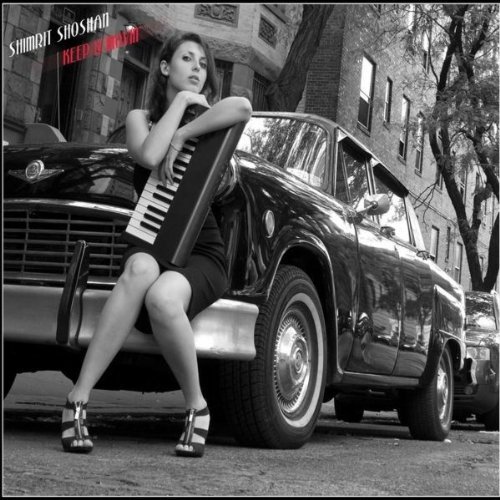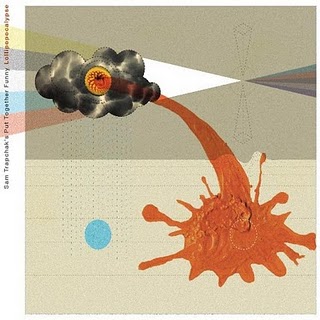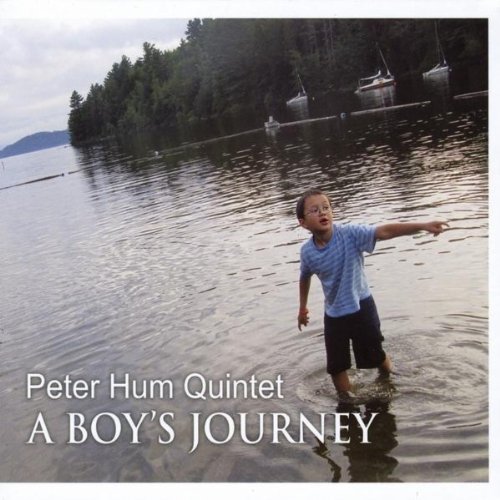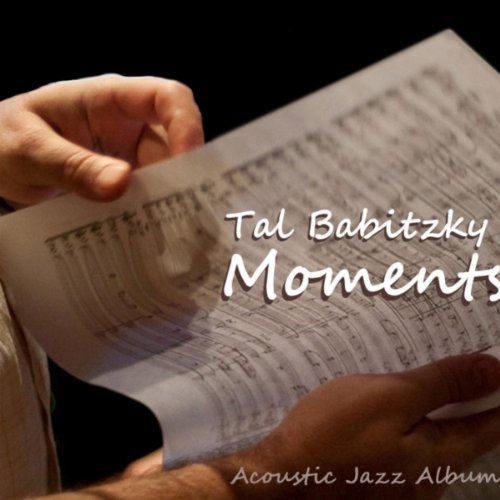Welcome to another edition of Music Diary Reviews! I had assumed that things would slow down after the ’embarrassment of riches’ we got in 2010, but I am already swamped with loads of great new music releases! I am continuing the trend I started of separating reviews into logical chunks such as new releases or reissues. For this set I am focusing on young and relatively unknown artists.
One of the great things about doing these reviews is the exposure to great new music by people I wouldn’t have heard about otherwise. At the end of last year and early this year I was contacted by three artists each of whom had new recordings. As I tend to do before committing to a review, I checked out each of the artists since I had never heard of them – and I was thrilled at the quality of the music I heard in the clips available online. So I bought two of the recordings (the third wasn’t available for me to buy digitally) and contacted each of them. In January I came across the new release from artist and journalist Peter Hum, and suddenly I had four excellent recordings by musicians very few people knew about.
Something that is very interesting to me is the contrast between pop and jazz artists and what is expected and required. People praise Justin Bieber because he can bang sticks on drums in some semblance of time-keeping and because he can plunk out a few basic chords on a guitar, and Taylor Swift because she writes songs – even if the songs all sound fundamentally the same, and derivative at that! Each of the artists featured here demonstrates a mastery of their instrument, the ability to navigate through a jazz tradition as diverse as Jelly Roll Morton and Derek Bailey and John Coltrane and David Sanborn, absorb it all and translate it all through their own personal perspective. It is simply stunning to think what listeners of modern jazz expect as the minimum entry level skill set these days – and all of these artists greatly exceed those expectations.
Since then I have found other new releases in jazz and pop, including some lesser known folks, but ultimately I saw the opportunity for a theme: these four recordings are ALL worth buying, and they are by young jazz artists you have never heard of … but you should! I have ordered them as usual according to my preference, and I was honestly surprised at how naturally I decided which to place ‘first’ and ‘last’ – I was surprised because as I said these are ALL excellent recordings!
Enough of the rambling, let’s get to the reviews! Here are four new releases by new artists who deserve loads more attention than they are getting –

Shimrit Shoshan – Keep It Movin’
Summary: The world of piano-centric jazz has been a creative hot-spot recently with great recordings from Vijay Iyer, Jason Moran, Matthew Shipp and many others. Pianist Shimrit Shoshan enters that fray with her debut recording “Keep It Movin'”, featuring her in trio and quartet acoustic settings. The music is inventive, challenging and entertaining, and it is quite simply one of the best recordings I have been fortunate to enjoy in the last year.
There is a single cover song amongst the Shimrit Shoshan originals on this record, Thelonius Monk’s ‘Skippy’. So perhaps it isn’t surprising that the opening song Shimmy ‘n’ You starts with a very angular style of playing. But what is surprising is that Shoshan is quickly demonstrating a style that is simultaneously smooth and angular, jarring yet pleasant. I fell in love with this record during the first song, and I have listened to it all the way through at least three times a week since I grabbed the CD in early January – and I still love it every bit as much.
I would describe Keep it Movin’ as modern jazz, but that is a term that has little real meaning, so let me add some context. For me modern jazz encompasses ‘straight-ahead’ and mainstream styles without being constrained by them; it shows a knowledge and fluency to more avant-garde forms without ever crossing into that realm fully. And I feel that part of being modern is encompassing a knowledge of rock, pop and fusion music of the last few decades, but how that knowledge is demonstrated can vary wildly. In short, Vijay Iyer is modern jazz, whereas Matthew Shipp is avant-garde, and Wynton Marsalis and similar artists are straight-ahead. For me the beauty of modern jazz is that it is at once visceral and cerebral, challenging and yet something I can play for my wife and kids.
Keep it Movin’ contains eight tracks featuring pianist Shimrit Shosham along with her group featuring Abraham Burton on saxophone, drummer Eric McPherson, and John Hebert and Luques Curtis on bass. The album opens with Shimmy ‘n’ You, which as mentioned features a syncopated angular style that is mysterious and intriguing. Quickly the song settles into a counterpoint between an optimistic melodic unison phrase and the intriguing syncopation. That sets the pace for the solos from Burton and Shoshan, which are tight and direct and never feel like that are wasting space or notes. Shoshan is a generous accompanist, filling out the harmonic structure for Burton, and also backing herself fully to the point of sounding like a second pianist throwing out ideas at times!
One observation about her style is that it tends to be harmonically very dense – and in this way is similar to Vijay Iyer, but with a different approach. I was reminded of this similarity with the ‘swirling’ harmonic motions of songs like With the Birds and the title track. It was after listening to those two tracks as well as Secret Identity in a row when ‘shuffling’ on my iPod that I really noted the distinct difference in the trio and quartet sounds on the songs. It isn’t about the addition of saxophone – everyone shifts roles appropriately … and yet it is more than just that. It is too easy for a trio to add a horn player and either make things cluttered or fade into the background accommodating the extra voice; similarly when a quartet moves to a trio it is too easy for everyone to maintain their roles and sound like a lounge band.
After noting how well the group worked as a trio, I assembled a playlist on my iPod featuring some great piano trios I currently have in my iTunes library, including Paul Bley, Vijay Iyer, Bill Evans, Jason Moran, Richie Beirach, Keith Jarrett, Brad Mehldau, Oscar Peterson, Chick Corea, Bud Powell and Matthew Shipp. Oh, and the trio songs from Shimrit Shoshan. While I am not suggesting that this has joined the pantheon of jazz trio recordings alongside ‘Waltz for Debby’, I was pleased at how well the music fit with all of the wonderful historical and modern trios. The sense of democratic contributions, the level of musicianship, and the creative exploration all fit in well with the other great trios on this list.
What I noticed first in the trios was bassist Hebert – similar to 2009’s Avery Sharpe recording, Hubert share equal harmonic footing with Shoshan, providing lyrical counterpoint, maintaining the fundamental structure and providing a great sense of rhythmic playfulness. Shoshan tends to have a dense style, but never overpowers the bassist – the level of communication in the trio is superb, and has me continuing to hear something new each time I listen. Likewise the quartet pieces wrap themselves around each lead instrument in turn -and I find myself sometimes preferring the trios and other times the quartets … but generally I just shuffle the songs and enjoy them all.
Choice Track (and why): Secret Identity – it is ironic that the video Shimrit Shoshan sent me was of this song, since it was my favorite already – and hearing her duet rehearsal with Eric McPherson only strengthened that feeling. ‘Enigmatic’ is my one-word description for this trio piece. You move from a slightly whimsical introduction to a sort of ‘cat & mouse’ structure, then to a hopeful passage and back to the second structure that has you questioning things again. All the time the trio is playing off each other in syncopated structures. If is fun and interesting, and the contributions are great by everyone.
You Might Love This If: You love piano-based jazz, great compositions, and songs that bring together the full jazz tradition and a modern awareness and sensibility.

Sam Trapchak’s Put Together Funny – Lollipopocalypse
Summary: At a recent concert by the collective school bands at our middle and high schools, a highly regarded composer from the region served as guest conductor on several of his pieces of music. After the show my older son remarked that ‘you could tell what instrument he played from the focus of the songs’. Indeed, in each song there was a trombone-focused segment. In most musical genres you can see this as a trend, but gifted bandleaders see the music beyond their instrument – you wouldn’t immediately identify the music of either Dave Holland or Charles Mingus as ‘bassist music’ because their compositions have a broad instrumental focus. The same is true with Sam Trapchak, who presents a wide stylistic range on Lollipopocalypse that doesn’t immediately suggest a leader or focus instrument, instead delivering a great set of collaborative songs with compositions from different members.
Perhaps that seems like a long-winded way of saying that I really like the CD, but it is more than just that. This is a debut CD, and you would expect to hear influences and roots and immaturity and growth all cobbled together – and you do. But on a debut you also can generally tell who is leading the session, and as I said before this feels like a collaborative effort. The band consists of Sam Trapchak on bass, Greg Ward on alto sax, guitarist Tom Chang, and Arthur Vint on drums. And it is a collaboration – Trapchak wrote five of the songs and Chang contributed two.
Sonically the group seems to take cues from just about every element of modern jazz, rock and fusion music. I was reminded of John Abercrombie’s 1970’s ensembles at times, or various John Scofield groups at others, of some of Dave Holland’s small group work, and even of Chris Potter’s ensembles. All of these groups are surely playing jazz, but bring in elements from any sort of music they happen to like. It is definitely difficult to categorize – but that is something I like, since it allows all of the musicians to be fully open to the experience!
The album kicks off with Ward playing a simple rhythmic figure on Different Dance, then Chang coming in with a counterpoint that fills out the harmonic structure. Then Trapckak and Vint form the background and Ward strikes off on the core melody in playful fashion. After a strong union bridge the original structures return but quickly segue into a solo by Trapchak that has him joined by Ward and Vint and then transitions into a solo by Chang before Ward takes the lead. All of this progresses so organically that it just feels like the natural progression of the song rather than a typical ‘head and solo’ arrangement. And even as each player takes the lead it isn’t as much of a ‘solo’ as leading the harmonic charge, since everyone else continues their strong backing and harmonic statements. For the final minute we return to the first minute, but with a renewed energy and fresh perspective.
Each song features strongly defined melodic and harmonic structures, as well as plenty of interplay between Ward and Chang on the melodies: on some it is about unison, harmony or counterpoint, and on others (such as Tongue and Groove) it provide a sense of free improvisation. But in all cases the strong compositions provide a great platform for the artists to express their ideas. And all four are great in both support and lead roles – in open improvisation spots Trapchak and Vint provide a solid foundation that keeps things on course while providing feedback and interplay at multiple levels.
As I mentioned, the debut solo recording by a jazz artist tends to be about the ‘potential’, seeing the young artist show what they will be able to offer … eventually. I created this article as a standalone to show that more and more artists are coming up ready to listen NOW. Greg Ward himself had a great 2010 debut recording (South Side Story), and Sam Trapchak has proven that he is a great bassist, excellent composer and bandleader, and someone to listen to now and in the future.
Choice Track (and why): On the Cusp of Cancer – one of two Chang compositions, this opens strong with a guitar centric statement and a guitar-alto melody which quickly transitions to Chang taking a distorted solo over a combined jazz-fusion beat that swings and rocks all at once. Coming out of Trapchak’s solo there is a very upbeat segment leading into Ward’s solo backed by Chang playing power chords over a shuffle beat with Trapchak holding it all together. It reminded me of some of the great stuff from Chris Potter’s excellent ‘Follow the Red Line’, with an energy that was difficult to contain!
You Might Love This If: You like modern jazz that takes chances but isn’t too far ‘out there’.
Unfortunately Sam Trapchak didn’t have any video links available as I published this, but promised something soon. For now, head to his web site and preview Different Dance using the Flash player.

Peter Hum Quintet – A Boy’s Journey
Summary: Many jazz fans who track the genre online likely follow Peter Hum on Twitter and read his stuff on his JazzBlog for the Ottawa Citizen (http://communities.canada.com/ottawacitizen/blogs/jazzblog/default.aspx) – that was certainly my introduction to him. OK, to be clear, Hum isn’t quite so young as the rest of the others here – but he has crafted an excellent debut recording that really deserves attention. It is carved out of the modern jazz tradition, with some songs reminiscent of Herbie Hancock’s Blue Note work of the 1960’s – yet it isn’t a nostalgia trip, as it is informed by everything that has happened since, and ultimately is a great collection of solid compositions and improvisations.
When you hear the beginning of Take the High Road, you are struck by the use of two saxophones to carry the melody. At first you expect a trumpet to join in at any time, but quickly accept the novel sound as it sets a tone that is strikingly different from one with a brass lead. You still get the two melody voices, but what I found was that the arrangements allowed more space for the piano to stretch out and fill in the harmonic space, and also let me always be aware of what the bass and drums were doing. In terms of the great players behind those instruments, Hum is working with Kenji Omae on tenor sax, Nathan Cepelinski on alto and soprano sax, Alec Walkington on bass and Ted Warren on drums.
Hum constructs his songs with long-form melodies over intricate harmonic structures that force the improvisers to work hard to produce interesting and innovative solos without falling into clichés or simple scale runs, and I was thrilled that the level of improvisation maintained the high level set by the compositions throughout. Big Lou, for example, seems like a complex ballad at first, then a simple blues tune once things get going, but it remains the same song – the core is deceptively simple with a rich structure woven on top. Hum switches to Fender Rhodes here and on a couple of other tracks, which opens up an entirely different set of sonic possibilities. The band keys off of that change and the structures feel more modern and funky.
My family always worries when I say ‘here … listen to THIS’ that it is going to be something like Anthony Braxton that will make their brains bleed, so they have been pleased that nothing in this article is like that. I have all four CD’s on a single playlist on my iPod and shuffle it up regularly and everyone enjoys listening. My wife has a particular love for La Tendresse, S.V.P. which is just a stunningly gorgeous solo piano piece. My sons prefer Unagi, with the funky tune that has such a singable melody they love.
There are many here I love – I chose Sojourner’s Truth below, but I could have chosen the title track as the opening piano and soprano figures make me swoon every time. The closing tune, Three Wishes, is another favorite, and another introspective piece with piano moving lazily over an ostinato bass before the more hopeful melody takes control. There is no shortage of great music here – it is the sort of thing that rewards intense listening but is also wonderful to just have on in the background as we make dinner or go about our business. It has taken Hum a long time to get to this debut CD … let’s hope he doesn’t keep us waiting so long for the next one.
Choice Track (and why): Sojourner’s Truth – after a funky two-chord piano figure and a bass-snare-hi-hit rhythm that reminds me of something from Miles Davis Live Evil, the horns come in with a long and winding melody that utterly sweeps you along like a current and brings you right into the core of the song. You don’t know where melody and improvisation begin or end, and you no longer care. I always find myself ‘waking up’ to the song structure about half-way through while enjoying the sax solos, and then submerging for the last couple of minutes and being surprised when the song ends.
You Might Love This If: You like more laid-back jazz forms, but want something fresh and new with great compositions and improvisation.
Here is a video of Peter Hum’s Quintet live from last November:
Tal Babzitsky
Summary: When I got an email from Tal Babzinsky about his latest CD, he touted that they “took nineteen of the best musicians in Israel in various instruments, and recorded twelve diverse tracks in one of the highest quality studios available.” Listening to Moments, that quality and attention to detail is apparent throughout – and while it is a strength for the most part, it is at times a weakness, and is the reason why this recording is at the ‘bottom’ of this article. I don’t want that to sound overly negative, as I made it clear that all four of these CD’s are solid and well worth buying. But it is this sense of polish that I found made the tracks all shine, yet seems to have held the entire production back from attaining its full potential.
Babitzky is the composer of all twelve songs as well as pianist, and this is his third recording. As he noted, he took a large number of instrumentalists and recorded the songs with only a small amount of rehearsal in order to get as fresh a feeling as possible. Strings were added in a later session to add to the environment, which works in some cases and makes things feel cold and over-produced in others.
For me the star of this recording is the compositions – he calls them “twelve diverse tracks”, but that barely begins to cover it. You have solid jazz tunes, songs that sound like they could be used as theme songs for a TV or movie yet still provide a great basis for improvisation, and some songs that seem to hint at larger form works crawling around in Babitzky’s head. But the songs are diverse in their sonic origins as well as thematic structure. Some have an Eastern European feel (Babitzky was born in Latvia), others feel like traditional western jazz, some have a Latin groove, and other have a Mediterranean approach. None of it feel forced or contrived – these are all elements on Babitzky’s broad compositional palette.
Moments begins with a haunting piano figure and a suspended chord sequence that provides for a sense of mystery, but after developing the melodic structure the song opens up and allows the soloists space for improvisation. The rhythm section provides great support for the soloists, and I was surprised at how open the space felt at times during improvisation after the rather controlled ensemble segments. This continues with Neon, with trade-offs between composed and improvised sections climaxing at the conclusion of the song.
City Secrets has a clear ‘soundtrack appeal’ – indeed my kids asked ‘what is that from?’, and when I replied ‘Tal Babitzky’ they pressed ‘no, what soundtrack’. I tend to have a large amount of soundtrack music on my iPod from my favorite games and movies, so I consider that to be a high compliment to someone who lists Ennio Morricone as a prime influence (since I also have Morricone on my iPod!). Feeling Love has a structure that could easily be turned into a ‘smooth jazz’ vehicle, but I like what they did with it here – it is pretty, but the underlying structure is solid enough for the soloists to make it more substantive.
My only real complaint is that while everything works well, I never felt that anything stepped ‘out of the box’. There were no risks taken, no moments where I felt like I was watching a high-wire act and wondering how it might all resolve. It is never boring, but neither is it ever a thrill ride – it is high quality, but not daring. Even the most upbeat tunes like Hysteria never really stretch out that far, but don’t take that to mean they aren’t enjoyable or a quality experience.
I am not sure if I have made my position clear on Tal Babzitsky’s Moments, or muddied it further! This is a high quality recording of strong compositions featuring excellent musicians – there isn’t a clunker in the bunch. Every song is perfectly executed and there is room for improvisation as well as intricate thematic development. My main issue is that it is too polished and these great artists never seem to push beyond their comfort zones. But that doesn’t stop this from being a very enjoyable CD that I would recommend to any instrumental music fan, particularly those who tend to avoid the ‘out there’ stuff I tend to favor and prefer more structured settings for improvisation.
Choice Track (and why): Discovery – I fell in love with the tune from the beginning, and while I had no idea what instrument would take the lead, the trumpet wasn’t it! But it ended up adding a nice contrast to the subdued rhythm section and strings. It is once again very pretty and a well thought out composition that I immediately connected with, and the improvisations only made it more enjoyable as each reflected upon the contrasting themes of the main melody.
You Might Love This If: You love more structured compositions and high quality mainstream jazz music.
Here is a video of Diagonal Stride from Moments performed live :
Conclusions
From the start I made it clear that I wanted to focus on excellent recordings that were made by little known artists whose work deserved much greater attention. Over the last couple of months I have spent loads of time listening to the four hours of music combined across these great CD’s, but at the same time new music has come in to challenge my listening. Stuff from Jamaaladeen Tacuma, Al Di Meola, Dave Liebman, Joe Lovano, Kevin Eubanks and more. Yet these four CD’s have maintained my attention, have shown that they not only make a great first impression but have compositions and improvisation that has made them maintain ‘mind share’ against such stiff competition.
I also noted that these recordings immediately ordered themselves for me, which is definitely true. Within the first week I knew that Shimrit Shoshan’s Keep It Movin’ was one of the best recordings I had heard in the last year, up with Mary Halvorson and Pat Metheny and Nik Bartsch. And inversely I knew that when it came time to prune back what was on my iPod that Tal Babitzky’s Moments would be the first to go, simply because it never really challenged me – it was high quality and very enjoyable, and not much more. Between the other two it was splitting hairs as both are excellent recordings that truly reward you with new joys each time you listen. What made my choice was shuffling my whole iPod one day and absolutely jamming to a song while busy with other things and suddenly realizing it was the end section of ‘On the Cusp of Cancer’.
In recent months I have quoted some staggering music sales statistics, particularly how so much of the money in the industry is tied up in <0.1% of artists, and how few artists actually sell enough music to earn a living wage. That is the reason I wanted to buy these recordings to review – I wanted to support the music I loved. Wil Wheaton quoted someone as saying ‘I act for free, I get paid to wait’. I have said in gaming reviews that I get paid in good free games for the terrible games I have to review. With these music reviews it was purely voluntary – I got to preview all four and then choose to buy or not before responding to each artist about reviewing. So I have already voted with my wallet – this is music that is worth purchasing and supporting the artists. Hopefully you will check out their stuff and choose to support them as well – I think it is critical to support this level of creativity and musicianship as much as possible.
Until next time, enjoy the great joys of whatever music you love!



RT @geardiarysite: Music Diary Reviews: You Don't Know Them … But You Should! http://bit.ly/gRIFVY @ShimritShoshan @peterhum @toko70
RT @txa1265: RT @geardiarysite: Music Diary Reviews: You Don't Know Them … But You Should! http://bit.ly/gRIFVY @ShimritShoshan @peter …
Music Diary Reviews: You Don't Know Them … But You Should! | Gear …: One of the great things about doing these… http://bit.ly/f5yZej